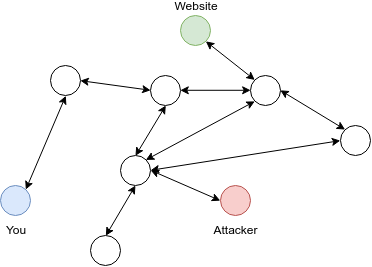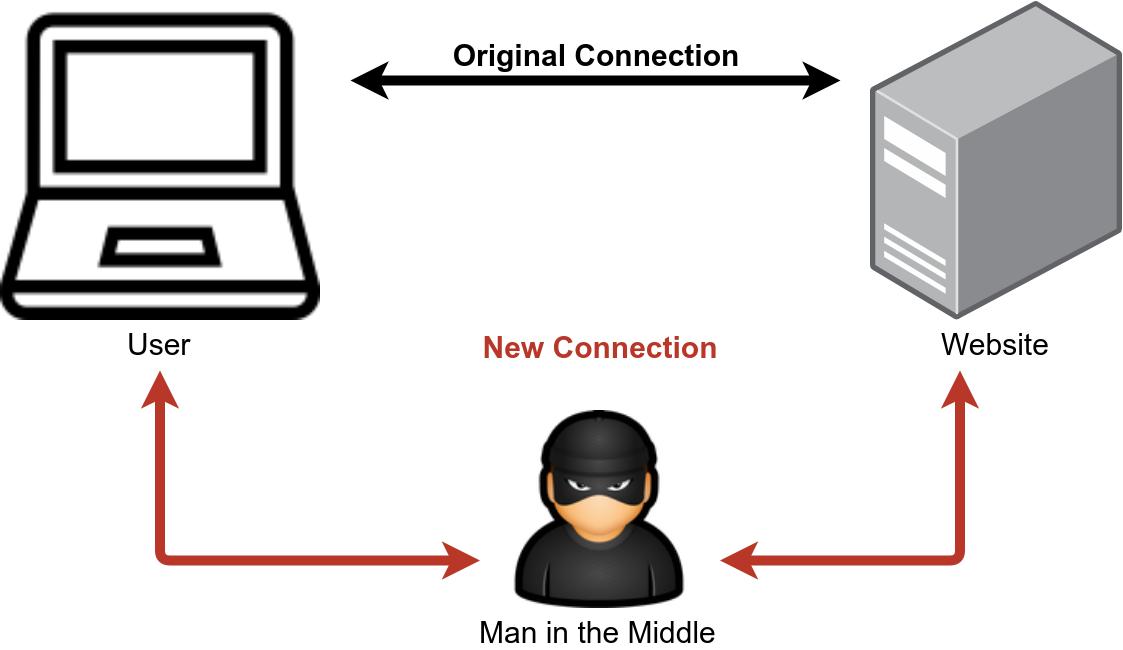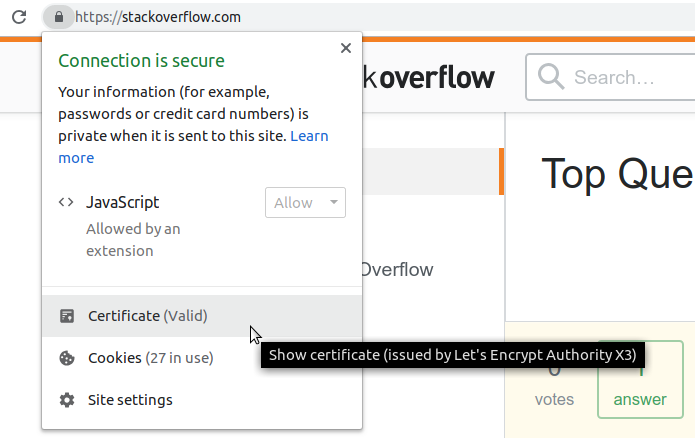Transport security is an important topic nowadays. We don't want a man in the middle (MITM) to be able to read our communication with banks, our e-mails, or our medical apps. Hence we need encryption of our data at the transport layer level.
The Problem of Internet Connections
The internet is a network. It is not connecting your machine with every other one directly, but uses nodes in between. As it is basically connecting everybody, you also have some attackers within the network:

The internet is engineered in a way that very often you can imagine the connection between you and a service as a direct one, although it is not direct. That connection is not save. At the very least you can imagine people reading your traffic (e.g. when you use a wireless connection that's called WLAN Sniffing, the same thing works when you're in the same network). In a worse case they might be able to change your communication. These types of attacks are called Man-in-the-middle attack:

The Solution: Public-key cryptography
There is a super neat technique called Public-key cryptography. It enables you to generate two keys. We call one of them the public key and the other the private key.
Imaginethem as a combination of keys / locks: * Stuff that is encrypted (locked) with the private key can only be decrypted (unlocked) with the public key * Stuff that is encrypted with the public key can only be decrypted with the private key.
So we make the pulic key ... well, public. Meaning we share the public key with the world. Whenever somebody wants to send us a message, they can use our public key and only we will be able to read it as long as we keep the private key private.
The Problem of Manipulating MITM
Public-key cryptography is awesome, once we have shared the public key with the world. But we might not even get that far, if an attacker manages to intercept our messages. The attacker could share his public key with the world instead. Then, when somebody wants to have a private communcation with us, they use the attackers public key. The attacker reads the message, decrypts it with our public key and we think everything was fine.
The Solution: Certificate Authorities
A Certificate Authority (CA) is a trusted third party. A certificate is a digital document which says "This public key belongs to that domain". It is bascially again public key cryptography, but with a trusted third party. The website owner sends their public key to the certificate authority. The authority makes sure that it was actually send from the domain. If that is the case, the CA signs the public key with their private key. The public key of the CA is well known (e.g. delivered with the browser at installation).
The Problem: Compromised Certificates
It can happen that an attacker gets temporary access to the web services server. Then the attacker can copy the private key of the service.
The Solution: OCSP Stapling
The web service has to revoke the certificate. This means it has to tell the CA that the private key was compromized. But how does the client (user) get to know about this?
Three possibilities: CRL, OCSP, & OCSP stapling.
There is a pretty good video about Revocation of digital certificates: CRL, OCSP, OCSP stapling.
Essentially, OCSP stapling means that the server lets the CA not only certify the private key, but also add a timestamp.
Overview of Certificate Authorities
You can see the Certificate Authority in Chrome by clicking on the lock icon left of the URL:

Commonly used Certificate Authorities are:
- Let's Encrypt: Used by BMW, StackOverflow, ccc.de, kit.edu
- DigiCert: Used by Reddit, Twitter, Audi, Amazon, mozilla.org, Instagram, live.com, netflix.com, ebay.com, emirates.com, paypal.com, n26.com, deutsche-bank.de
- GlobalSign: Used by Wikpedia, Baidu.com, qq.com, post.de
- GeoTrust: nokia.com, tk.de, sixt.com, qantas.com, mit.edu
- Entrust: comdirect.com
- Comodo: namecheap.com
There are also some German ones:
- D-Trust: sparkasse.de, elster.de, bundesdruckerei.de
- ZIVIT: bund.de
- Telesec: bundesregierung.de, telekom.de
- DFN-Verein: tum.de, uni-muenchen.de, uni-heidelberg.de, charite.de, rwth-aachen.de, fernuni-hagen.de
Microsoft and Google have their own CA. It's a bit weird that Microsoft uses Digicert for live.com.
You might also be interested in features of a CA.
| CA | Price | Founded in | Employees |
|---|---|---|---|
| Let's encrypt | Free | 2014 | 13 |
| DigiCert | $218 / Year | 2003 | 1000+ |
| GeoTrust | $149 / Year | 2001 | |
| GlobalSign | $349 / Year | 1996 | |
| Entrust | $199 / Year | 1994 | 350 |
| Comodo | $89 / Year | 1998 | 1200+ |
I was not happy with the usage numbers. Let's encrypt claims to have 152 288 000 domains (2018-12-30, source), but w3techs.com says they have a market share of 0.1%. According to them, IdenTrust has a market share of 49.9%, Sectigo of 25.0% and Digicert of 13.6%.
SSL, TLS and HTTPS
Here are super short explanations what the important terms mean:
- SSL (Secure Sockets Layer)
- A cryptographic protocol used for network traffic
- TLS (Transport Layer Security)
- An updated version of SSL.
- HTTPS (Hypertext Transfer Protocol Secure)
- Using HTTP with transport layer encription (e.g. SSL or TLS)
- Certificate
- An electronic document used to prove the ownership of a public key.
Nginx SSL options
You can find options for nginx at cipherli.st, mozilla.github.io as well as in certbot.
| Config | Miguel Grinberg | cipherli.st | certbot | Explanation |
|---|---|---|---|---|
| ssl_session_timeout | 1d | 10m | 1d | The lower this value, the higher the load on your server and the higher the security. |
| ssl_prefer_server_ciphers | on | on | on | tell the client that we have a preferred order of cipher suites |
| ssl_protocols | TLSv1 TLSv1.1 TLSv1.2 | TLSv1.3 | TLSv1 TLSv1.1 TLSv1.2 | The higher this value, the more likely there are some devices which don't support it |
| ssl_ciphers | MANY! | EECDH + AESGCM:EDH + AESGCM | MANY! | |
| ssl_session_cache | shared:SSL:50m | shared:SSL:10m | shared:le_nginx_SSL:1m | |
| ssl_session_tickets | off | off | ||
| ssl_stapling | on | on | OCSP | |
| ssl_stapling_verify | on | on | verification of the OCSP responses received from the CA | |
| HSTS | add_header Strict-Transport-Security max-age=15768000; | add_header Strict-Transport-Security "max-age=63072000; includeSubDomains; preload"; | Tell the client that we don't like HTTP | |
| add_header X-Frame-Options DENY; | make sure it is not embedded in a frame or iframe | |||
| add_header X-Content-Type-Options nosniff; | See Content sniffing and mozilla.org | |||
| add_header X-XSS-Protection "1; mode=block"; | mozilla.org, stackoverflow |
You might also want to redirect http to https (return 301 https://$host$request_uri;). HSTS is the more secure option, though.